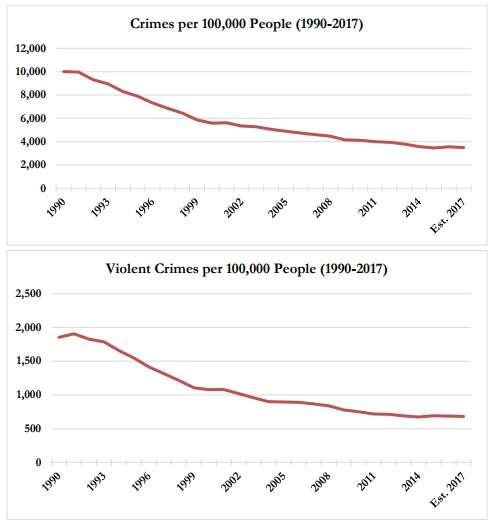The Crime Wave That Wasn't Happening, Still Isn't Happening
Preliminary estimates for 2017 show small drops in violence and murder.

Violent crime is apparently refusing to participate in America's revisit to the 1990s. Preliminary estimates for 2017 suggest that in all likelihood we'll end this year seeing fewer crimes than we did last year, and certainly less than we did in the '90s.
President Donald Trump and Attorney General Jeff Sessions have used a recent increase in violent crimes in some major cities (particularly Chicago) as an excuse to attack Barack Obama's modest scaling back of the drug war. But for all of Trump and Sessions' fearmongering that we're going to be murdered by illegal immigrants or drug lords (or illegal immigrants who are also drug lords), their rhetoric has never been grounded in the truth about crime trends.
The latest report from the Brennan Center for Justice (a policy institute at the New York University School of Law) gathers data from police at America's 30 largest cities. If current crime trends continue for the rest of the year, these cities will see their second-lowest collective crime rates since 1990:

Overall crime looks like it may drop 1.8 percent. Violent crime is projected to fall .6 percent. Individual city numbers vary, though. New York is seeing a significant drop in violent crime while Houston is seeing an 8.8 percent rate increase. Chicago in 2017 is seeing less of a violent crime increase (1.6 percent) than Los Angeles (2.8 percent).
This year's murder rate, meanwhile,
is projected to be 2.5 percent lower than last year. This year's decline is driven primarily by decreases in Detroit (down 25.6 percent), Houston (down 20.5 percent), and New York (down 19.1 percent). Chicago's murder rate is also projected to fall, by 2.4 percent. The 2017 murder rate is expected to be on par with that of 2009, well at the bottom of the historic post-1990 decline, yet still higher than the lowest recorded rate in 2013. Notably, more than half the murder increase from 2014 to 2017 (55.6 percent) is attributable to two cities—Chicago and Baltimore. This year's decrease could indicate that the increases in 2015 and 2016 were short-term fluctuations in a longer-term downward trend.
What this report is not capable of analyzing is whether the drop in violent crimes being reported to the police actually means fewer crimes are happening. Major cities with high levels of immigration (including illegal immigration) have been reporting reductions in certain types of crimes (like domestic abuse). Police officials worry that the drop isn't actually real, and that immigrants are increasingly afraid to report crimes for fear of getting tracked down by Immigration and Customs Enforcement and deported.
Oh, and lest Trump and Sessions attempt to give their drug war crackdown credit for falling crime: So far Trump's Department of Justice has actually been prosecuting fewer people for drug crimes than Obama's Justice Department—a nine percent drop from 2016 to 2017. If crime came down while drug war prosecutions were declining, that just might be a sign that drug enforcement isn't a good way to lower crime rates. But don't hold your breath waiting for this administration to realize that.


Show Comments (19)